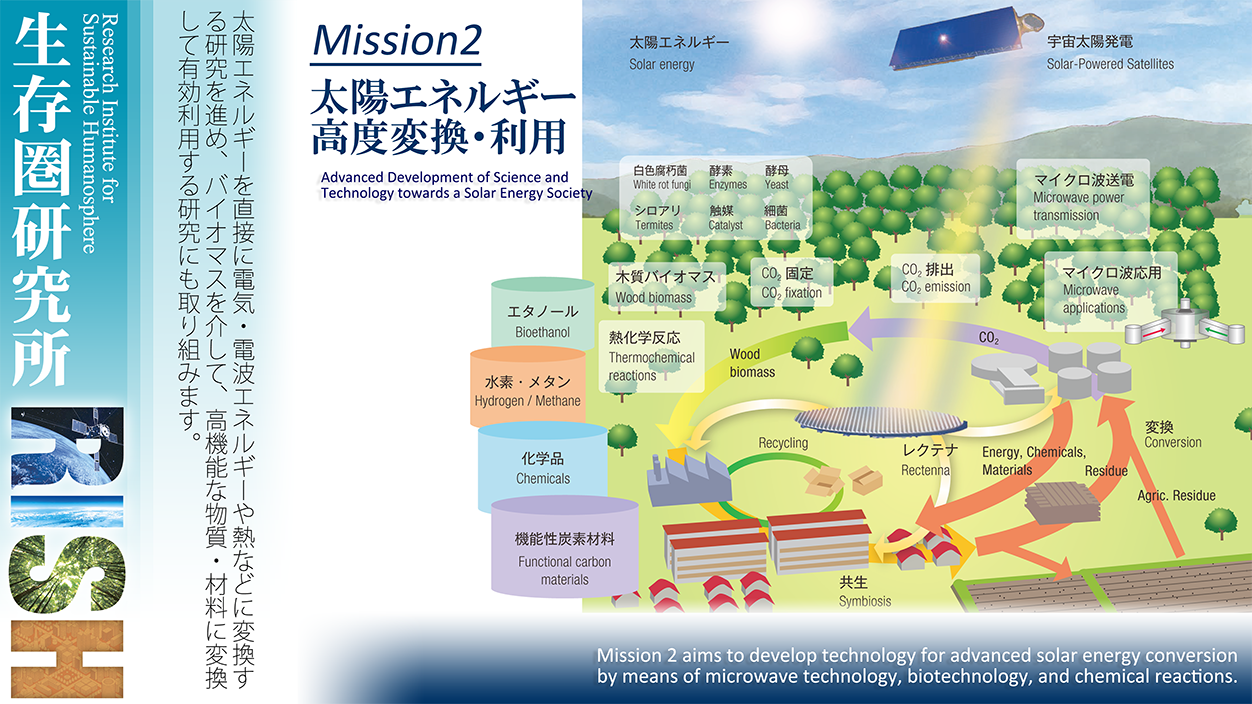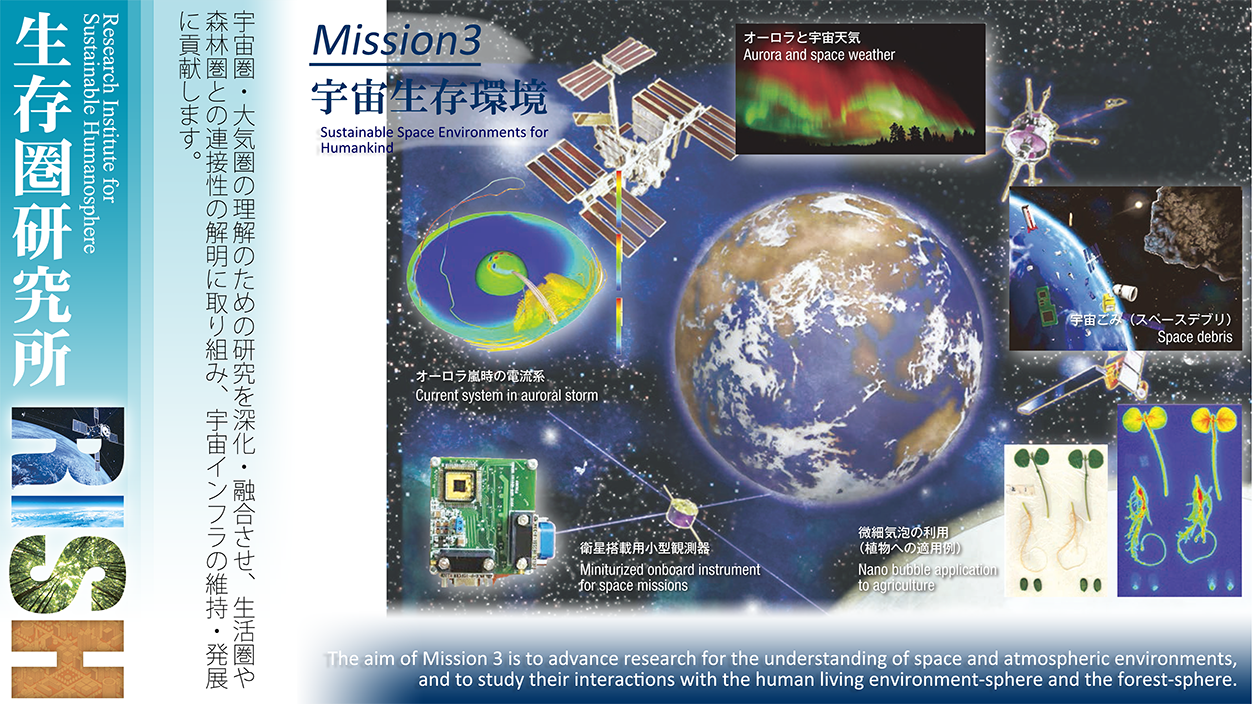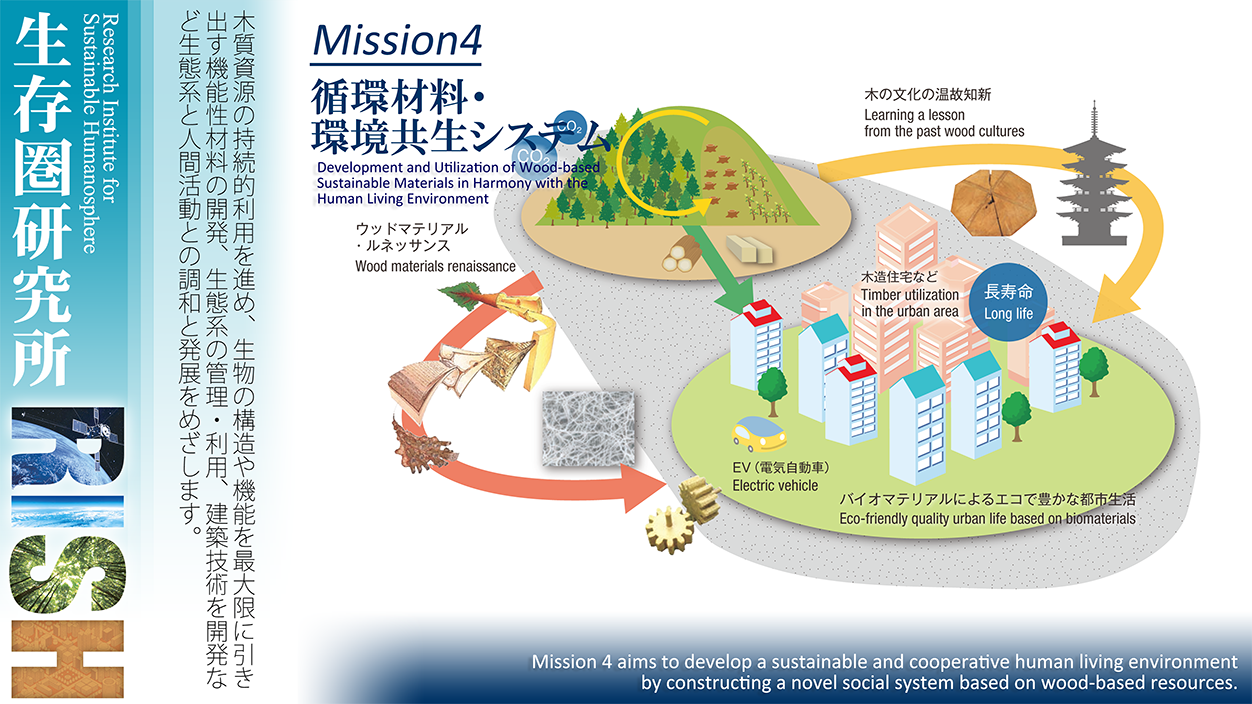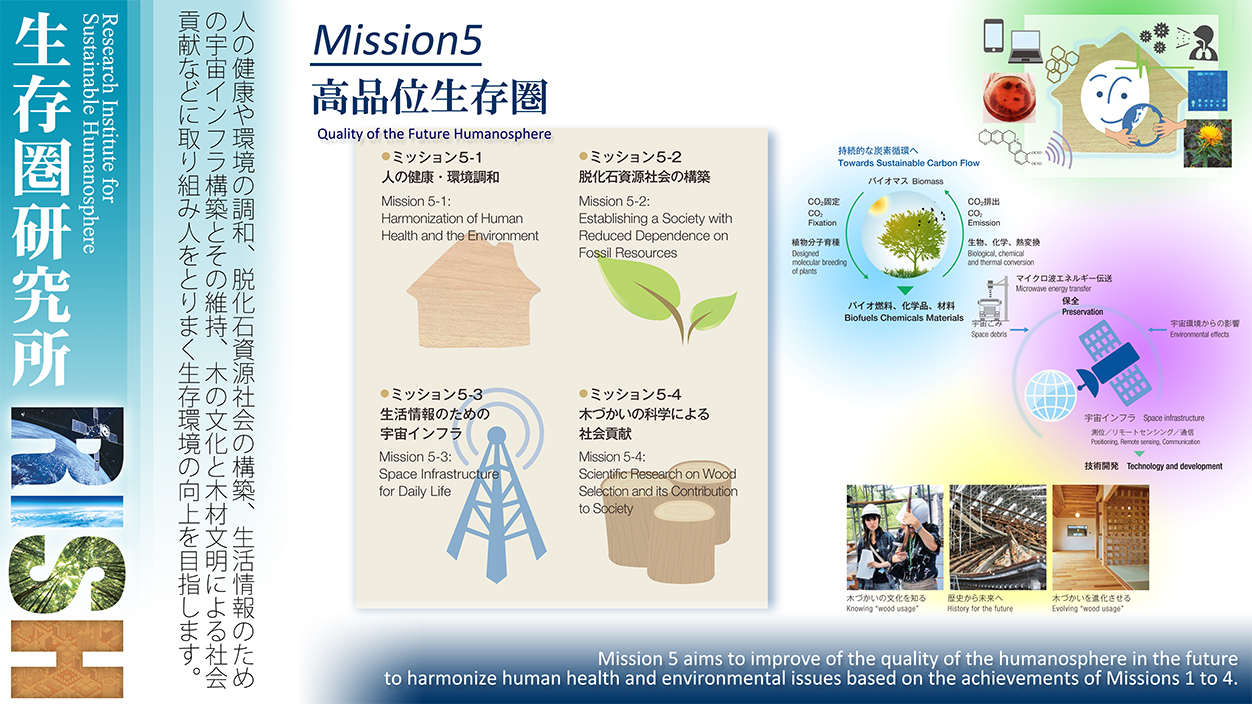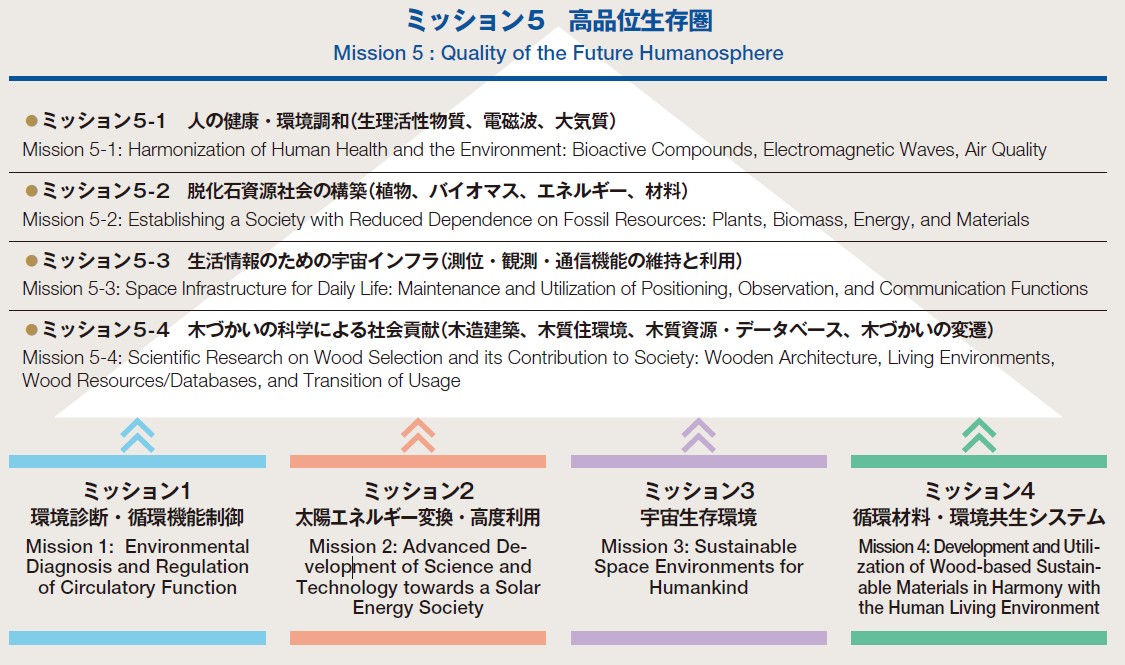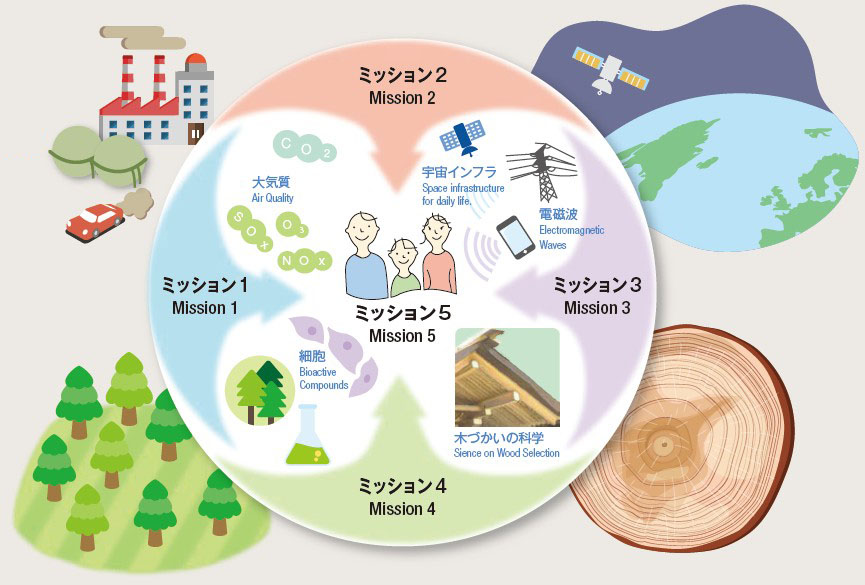Research Missions
更新日: 2022/06/07
5 Missions for a Sustainable Humanosphere
RISH expands its Joint Usage/Research Center activities in line with its four missions: “Mission 1: Environmental Diagnosis and Regulation of Circulatory Function”, “Mission 2: Advanced Development of Science and Technology towards a Solar Energy Society”, “Mission 3: Sustainable Space Environments for Humankind”, and “Mission 4: Development and Utilization of Wood-based Sustainable Materials in Harmony with the Human Living Environment”. In 2011 RISH founded “New Frontier Research”, which understands the environmental changes that affect human health and finds the measures that lead to healthy, safe and secure living. In 2016 RISH revised and expanded its missions and defined a new mission, the “Quality of the Future Humanosphere”, which pursues practical applications of research to create healthy and sustainable living environments. This new mission emphasizes social connections, internationalization, and energy and materials recycling.
Establishment of Safe and Secure Humanosphere for Human Life
RISH Research Missions
Mission 1: Environmental Diagnosis and Regulation of Circulatory Function
To develop projections of environmental change, such as global warming and the increase of extreme weather events, this mission diagnoses atmospheric conditions by highly sensitive radar and satellite measurements. This work elucidates the mechanisms of material transport and exchange between the biosphere and the atmosphere to establish a fossil fuel-independent sustainable production and utilization system based on biomass resources. Mission 1 includes the underground biosphere in its research, viewing the whole humanosphere from a materials circulation perspective. In doing so, the biological functions of plants and microbes involved in the circulation of materials are analyzed and regulated.
Mission 2: Advanced Development of Science and Technology towards a Solar Energy Society
Mission 2 aims to develop technology for advanced solar energy conversion by means of microwave technology, biotechnology, and chemical reactions. We study the direct conversion of solar energy into electric and electromagnetic wave energies, as well as the indirect conversion of solar energy into highly functional materials via wood biomass, a carbon fixation product of photosynthesis. Mission 2 intensively focuses on the conversion of solar energy to highly functional materials, which includes an understanding not only basic humanosphere science but also how total systems are implemented in the humanosphere.
Mission 3: Sustainable Space Environments for Humankind
The aim of Mission 3 is to advance research for the understanding of space and atmospheric environments and their interactions with the human living environment-sphere and the forest-sphere by using satellites, space stations, sounding rockets, ground-based radar, and computer simulations. This mission also aims to respond to the societal demand for the utilization of sustainable space environments by deepening our understanding of the fluctuations in radiation belts and geomagnetic storms due to solar flares and by proposing measures to tackle threats from space, including potentially hazardous space debris and asteroids. For example, we study an engineering approach to prevent asteroid impacts on the Earth, as these events cause severe damage. This mission not only deals with understanding and utilizing space environments, but it also emphasizes the maintenance and improvement of space environments for daily human life, as well as interactions with the atmosphere, the forest-sphere, and the human living environment-sphere.
Mission 4: Development and Utilization of Wood-based Sustainable Materials in Harmony with the Human Living Environment
Mission 4 aims to develop a sustainable, renewable and cooperative human living environment by constructing a novel social system based on wood-based resources. To create harmony between nature and human activities, this mission focuses on human habitation by examining biologically-based and sustainable materials, the architectural function of structures and the human habitability of these structures. Technologies with low environmental impacts are possible if the structure and function of these bio-resources is well understood. Our research is directed towards the development of these technologies throughout the carbon life cycle, including the manufacturing, modification, use, disposal, and recycling of wood-based materials. The principle of this mission is to unify state-of-the-art technologies in engineering, agriculture, biology and anthropology through wood and material sciences. This mission is designed with creativity in mind and will be conducted through the development of novel ideas and thinking. Nonetheless, ancient knowledge and techniques will still play an important role in this mission to uphold a safe and pleasant environment on earth.
Mission 5: Quality of the Future Humanosphere
Rapid expansion of human industrial exploitation has brought drastic changes to various aspects of the humanosphere, which threatens human health and the circumstances necessary for a safe and secure life. The purpose of Mission 5 is to take effective measures, based on the achievements of Missions 1 to 4, to harmonize human health and environmental issues, establish a society independent from fossil resources, maintain a space infrastructure that supports the human living environment, and contribute to society by creating a renewable wood-based civilization. In this way, Mission 5 aims to improve of the quality of the humanosphere in the future. This mission is based on collaborative research activities carried out from 2011 to 2015 as “Frontier Research on the Sustainable Humanosphere”, which is an institute-driven top-down project studying the five main themes for human life by means of humanosphere sciences.
Mission 5-1: Harmonization of Human Health and the Environment: Bioactive Compounds, Biological Effects of Electromagnetic Fields, and Air Quality Issues
This mission addresses divergent themes related to human health and environmental harmonization, namely, bioactive compounds derived from plant mass, evaluation of biological effects of electromagnetic fields, and air quality issues surrounding human environments.
Mission 5-2: Establishing a Society with Reduced Dependence on Fossil Resources: Plants, Biomass, Energy, and Materials
In this mission we study microwave energy transfer, plant breeding and the conversion of plants to energy, chemicals, and materials to contribute to a society with reduced dependence on fossil resources.
Mission 5-3: Space-Atmosphere-Ground Interaction in Daily Life
Space systems provide navigation, observation, and communication
functions in our daily life. These functions are heavily dependent on
space and atmospheric environment as well as ground systems.
Mission 5-3 includes researches such as space debris observation by
MU radar, atmospheric study by navigation and observation satellite
systems, and effect of space environment to ground power system.
Mission 5-4: Scientific Research on Wood Selection and its Contribution to Society: Wooden Architecture, Living Environments, Wood Resources/Databases, and Transition of Usage
Research into the exchanges between wood-based cultures across the world will provide new understandings about mutual relationships with Japan. Future living environments based on this accumulated knowledge of “wood usage” will lead to the establishment of a more sustainable society.
2021 Activity Reports for Missions
- Mission 1: Environmental Diagnosis and Regulation of Circulatory Function
- Mission 2: Advanced Development of Science and Technology towards a Solar Energy Society
- Mission 3: Sustainable Space Environments for Humankind
- Mission 4: Development and Utilization of Wood-based Sustainable Materials in Harmony with the Human Living Environment
- Mission 5-1: Harmonization of Human Health and the Environment
- Mission 5-2: Establishing a Society with Reduced Dependence on Fossil Resources: Plants, Biomass, Energy, and Materials
- Mission 5-3: Space-Atmosphere-Ground Interaction in Daily Life
- Mission 5-4: Scientific Research on Wood Selection and its Contribution to Society: Wooden Architecture, Living Environments, Wood Resources/Databases, and Transition of Usage
2016-2020 Activity Reports for the current Missions
The former 4 missions
The main objectives of RISH from 2004 to 2015 were to understand the conditions of Humanosphere as accurately as possible (diagnosis), and to provide solutions to the problems of Humanosphere (remedy). For these purposes, RISH pursued interdisciplinary research centered on the four missions from 2004 to 2015.
Modified: 3 October, 2017.



